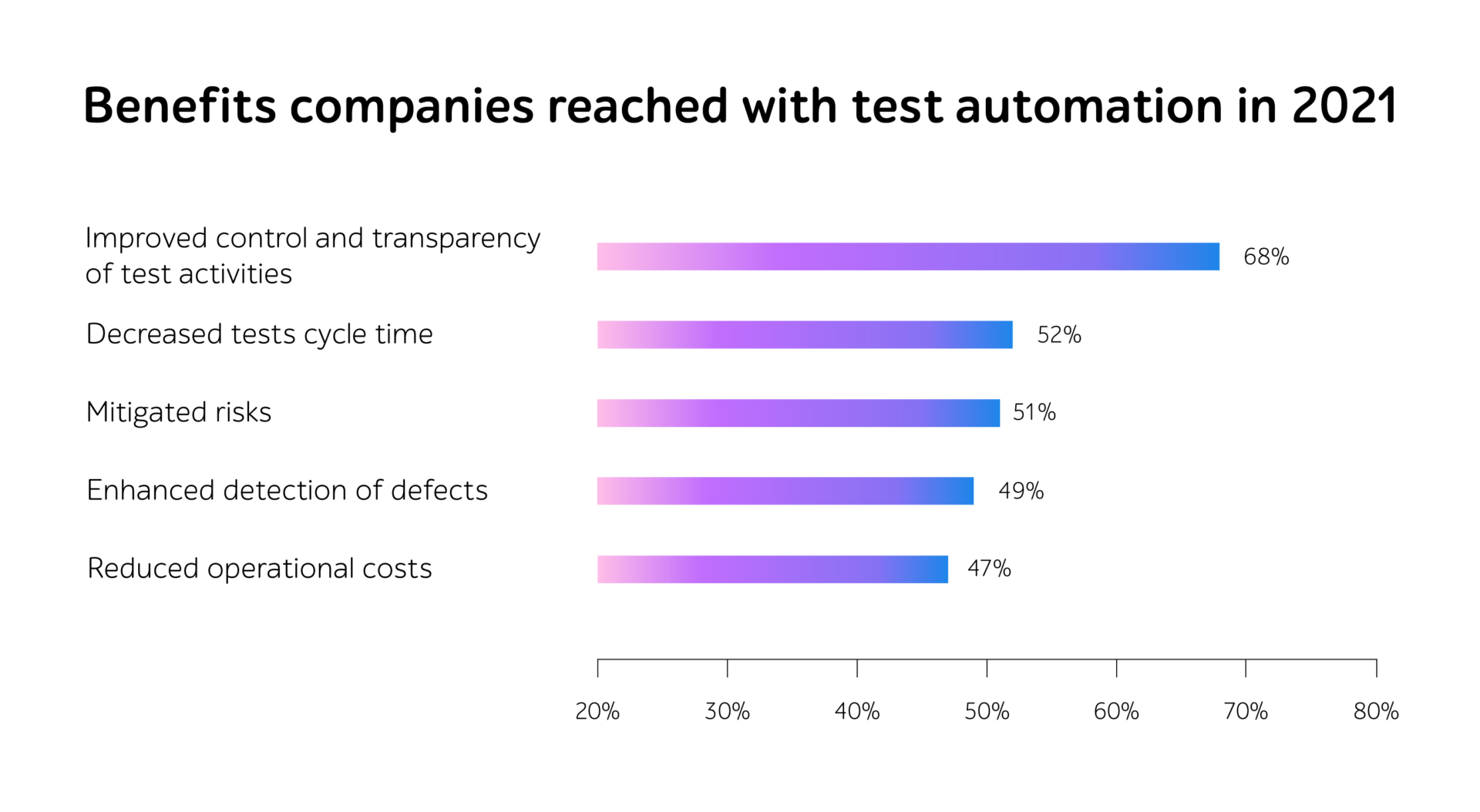
Continuous testing 101: a comprehensive guide
The world is changing, and the same goes for technologies. You can hardly imagine the software that doesn’t need improvements and updates, can you?
But how to manage constant modifications confidently while delivering a competitive IT product? And that’s where continuous testing comes in to support businesses in boosting apps quality and winning the high market race.
In the article, let’s discover…EVERYTHING about continuous testing: perks it provides for companies, reasons to adopt it, and 6 core steps to make to smartly integrate it into business processes.
Shaping a complete picture: why do companies need continuous testing, and what do they get in return?
These days, we are witnessing a mass-scale adoption of flexible methodologies. The 15th State of Agile Report indicates that 94% of surveyed companies are practicing Agile while 74% of respondents are implementing DevOps. What are the reasons behind these high rates? Constant changes. In the market, across the software development process, and end-user behavior patterns. And Agile and DevOps perfectly assist in addressing all of them.
However, businesses want a bit more than just producing a top-notch IT solution. What if the goal is to deliver high-quality products at a fast pace with innovations at the core? Then, it’s essential to integrate continuous testing (or CT, for short).
The common question is, “How can the company understand that it’s time to adopt continuous testing?” Here, there are 3 critical factors to bear in mind.
Factor 1. Working in a highly competitive market
For several decades, the world has been in the constant flow of technological change, with many industries experiencing disruption — from streaming companies to hospitality and automotive. With more organizations applying AI, IoT, AR/VR, and other technologies to boost customer experience and hold the attention of picky end users, remaining competitive has come to the fore. Adopting CT helps test early, often, and faster, delivering quality software.
Factor 2. Following regular release cadence
Amazon deploys every 11.7 seconds, and other companies attempt to reach the same results. Continuous testing, in its turn, allows keeping up with this pace, significantly reducing the testing cycle time and helping deliver high software quality at speed. At really high speed!
Factor 3. Striving to enhance software quality
To increase the odds of success in the market and deliver IT products that attract end customers, companies continuously do their best to improve software quality. CT allows them to establish a holistic quality assurance process by fulfilling tests throughout the entire SDLC, from the stage of early planning to deploying to the production environment. This means meeting the high software soundness, performance, and security.
It’s true that before introducing a particular service, companies need to know exactly what values it may bring to them. Let’s take a look at the 5 strongest benefits of continuous testing.
- Early mitigated risks. Timely feedback throughout the SDLC assists in promptly identifying blocking defects and eliminating them before the preparation of code.
- Smarter software release. Within Agile and DevOps, companies build an extremely flexible software development ecosystem with continuous release cadence.
- Effective QA workflow. Continuous testing allows shifting left and right at any SDLC stage while performing required QA activities at the necessary time.
- Boosted user experience. Timely performing test activities and conducting test automation throughout the SDLC keep the software code under exceptional supervision and prevent fault leakage. So, it helps improve CX, delight end-users with high-quality new functionality, and avoid business decline.
- Better teams’ integration. When evaluating the quality state from the very start of the project, all project members share QA value (as the time of siloed QA teams has passed). This streamlines effective collaboration, minimized downtimes, and high-grade code in production.
Building the 6-step plan of continuous testing
Now, let’s proceed with the steps to make to introduce CT with confidence.
Step 1. Conduct exploratory testing
Yes, test automation is an excellent choice for those wishing to check whether code changes haven’t affected existing functionality. But test automation alone can’t truly define if the features live up to set expectations.
It’s vital to perform exploratory testing as a first step in assessing the quality of a product. It helps identify issues that are hard to notice during other software testing approaches, simplify the cooperation of the cross-functional team, and find issues before introducing automation.
Step 2. Prioritize risks and perform test design
Modern software testing solutions are characterized by increased complexity due to multiple innovations at their core. And often, the costs are too high to allow even a single defect to leak into the production environment as the software may be embedded in a medical device intended to save someone’s life, for example.
So, to detect issues quickly, it’s critical to define business risks, prioritize them, and create the right test coverage that you’ll be able to gradually increase to reach 90% and more.
Step 3. Introduce test automation
Test automation works miracles when it comes to improving QA efficiency and accelerating time to market without compromising on software quality. The latest World Quality Report shows that it also provides businesses with reduced operational costs (47%), enhanced detection of defects (49%), mitigated risks (51%), and many more.

Source: World Quality Report 2021-22
However, to get the greatest value from test automation efforts, it’s significant to do 3 things: define the right toolset based on your business needs and budget, teams’ capabilities; set up a stable approach to have real-time visibility into the current quality level; expand the coverage over time.
Step 4. Prepare the infrastructure for CI/CD
CI/CD pipelines are a core part of DevOps practice as they help boost project velocity, minimize manual efforts, and reduce the probability of errors during integration and deployment stages.
To release reliable software, companies should prepare their infrastructures for CI/CD by organizing pipelines, integrating them into the communication channels, and performing service virtualization.
Step 5. Establish procedures (related to processes based on minimizing business risks)
By following a sequence of steps, companies standardize procedure flows. It minimizes the probability of defects slipping into the production environment and decreases the QA budget required for their fixing.
For example, before rolling out a new feature, it’s vital to define business risks and create test coverage, consisting of step-by-step procedures. They include defining the scope of unit tests, component tests, and finally, end-to-end tests. It also allows easily tracing the roots of any problems by analyzing them during retrospectives.
Step 6. Measure progress
It streamlines determining the progress and getting insights into which parts of the implemented solution may work better and improve them. Here, you may analyze the influence of your actions, reanalyze the risks, and conduct a retrospective to achieve greater success.
Wrapping up
So, what do we have? The key factors for adopting continuous testing are working in a highly competitive landscape, following regular release cadence, striving for software quality enhancement.
About the benefits. With CT, companies mitigate risks early on, provide smarter software releases, enhance QA workflow, boost user experience, get better teams’ integration.
And that’s not all. Companies may follow a 6-step plan to implement it smartly and confidently.
Reach out to a1qa’s experts to get a personal consultation on adopting continuous testing.








